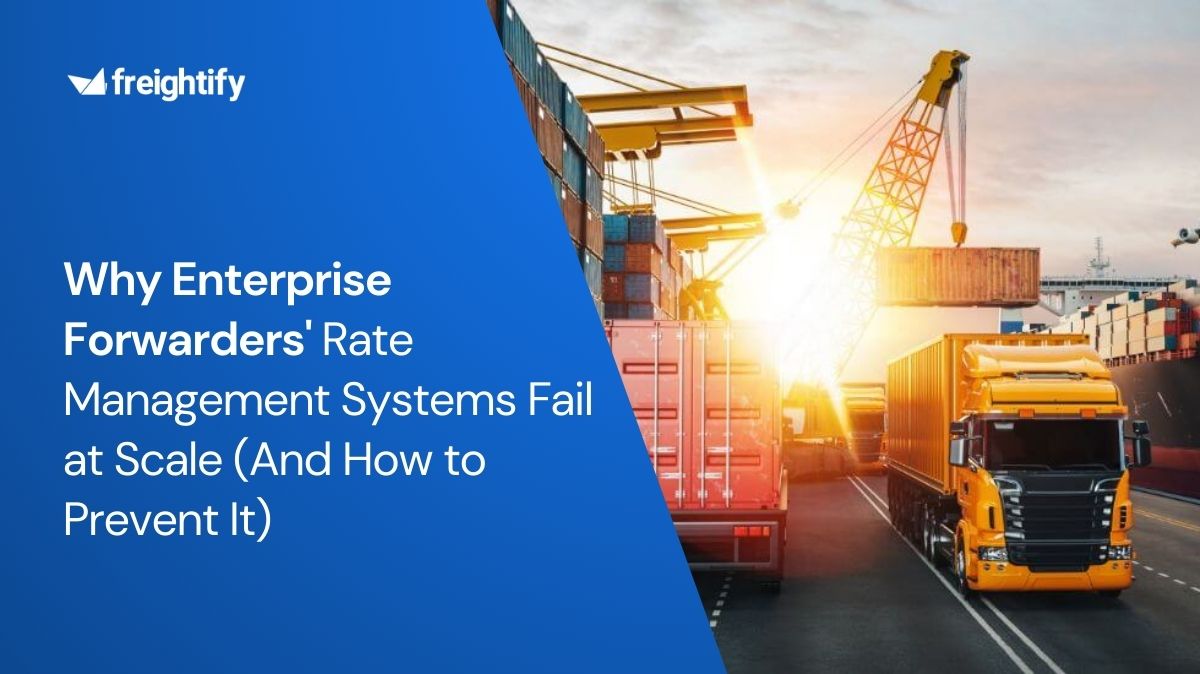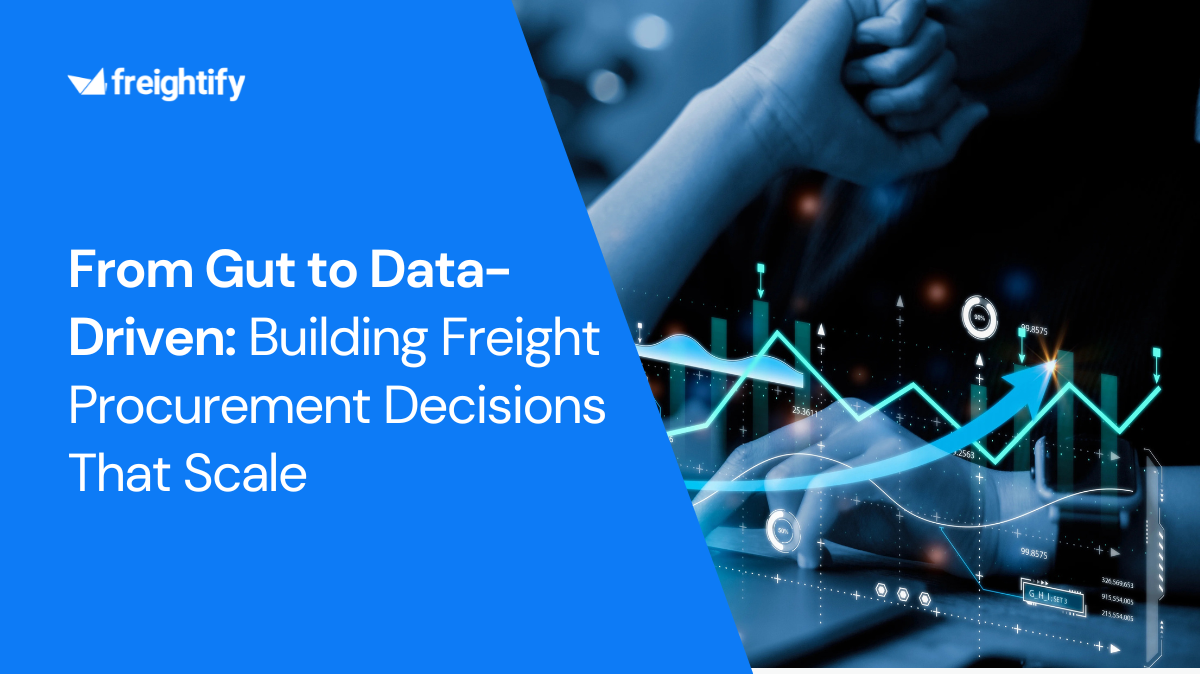Are you among one of the decision-making authority in a freight forwarding business?
Are you constantly questioning how to increase ROI of your logistics business?
Are you caught in a situation where you feel you do not have sufficient information to make a decision?
If you answered yes to any of the above questions, you are likely to be missing out on a key prerequisite that would link all your business operations together.
What's in this article?
Let us help you with your journey
Your one-stop solution to retrieve all live carrier rates & schedules in seconds!
What problem statements can be solved with tech implementation? The concept of data analytics and business intelligence through data interpretation is the missing jigsaw piece.
As a management professional in an organization with staff spaced across the globe, working in various time zones, with thousands of customers, it is very easy to miss out on the nuances that add value to the core service your teams deliver.
A million important questions could arise for any senior management professional while reviewing a forwarding business’s operations.
Which location gives the most business? Which team member converted the maximum business? Which team closes quotations swiftly? Where does all the customer’s cargo go to? What is the quantum of business per business unit? What is the quotation conversion percentage? How many liners have delayed deliveries? Which customers have asked for many quote revisions? Having an answer to each of these questions can help tweak and re-engineer the business processes to concentrate energies and investment towards maximizing returns.
All in one dashboard by Freightify to track different metrics Freightify aims to solve these practical difficulties through its interactive and customizable platforms. It aims to feed managers with the answers that they have always required.
The core of the solution is to equip senior management with data that augments business intelligence.
"With visibility and transparency throughout the supply chain system, swift and smart decision-making can be made possible" Why is visibility in supply chain important? Visibility is a key concept when discussing the decision-making process. It is almost impossible for leaders to decide on future action plans without understanding and knowing their business’s current metrics and parameters.
Real-time tracking is one aspect of the visibility spectrum. Back offices can track and mine data using a wide range of digital mediums.
Simple examples of this could include knowing where a carrier is delayed or identifying what status a quote is currently in. This could help identify bottlenecks quickly, giving leaders the time and data to make important decisions in overcoming these problems.
Another angle to the visibility concept is having access to smart reports generated through data analytics.
All the data mined through visibility software and other digitization platforms need to be interpreted and consumed.
Data Analytics can be used to convert data dumps into readable and comprehendible reports, charts, graphs, and tables that help managers understand their past and future trends.
Has the supply chain industry adopted visibility? KPMG consulting considers visibility to be one of the top 6 trends in supply chain and logistics in 2022. Many supply chain managers are currently troubled by a lack of visibility throughout their supply chains, as there are so many nodes and participants within the extended chain.
While it has been established that having heightened visibility can better the decision-making capacity, it is still unsettling to note that only 37% responders reported using in-transit visibility solutions in a recent study conducted by FreightWaves.
There is certainly more scope for improvement within the visibility space. JOC reports that visibility software adoption remains murky from a shippers’ or forwarders’ perspective.
The list of global and domestic visibility providers has grown in 2021 despite some consolidation; however, it has not been implemented by the supply chain industry.
Why is transparency in supply chain important? The Harvard Business Review defines transparency within the supply chain to be a requirement where companies know what is happening upstream in the supply chain and communicate this knowledge both internally and externally.
It is a concept that was relatively unknown 15 years ago.
Interestingly, the push for transparency comes from the consumers.
Researchers at the MIT Sloan School of Management found that consumers may be willing to pay 2% to 10% more for products from companies that provide greater supply chain transparency.
Transparency for internal stakeholders is just as important. Topics covering quality, safety, ethics, environmental impacts, suppliers, customers, products, and operations should be centrally collected and stored, allowing leadership to make more informed decisions.
Transparency boosts customer assurance and brand loyalty. It can help mitigate business risks and provides continuous improvements. It allows for sustainable practices. It builds stronger relationships with other global stakeholders like liners, agents, and government officials.
Ultimately, there is a sense of strong business ethics. It gives a competitive edge in this fragmented global market.
How can data analytics improve decision-making? Since the start of 2020, the supply chain industry has been shaken with surprises. Various disruptions have been overcome.
Business leaders were left asking if it would have been possible to predict any of these scenarios upfront. This is where decision support tools using predictive analytics come into play.
Credits - ratelinx.com
In the 21st century, having access to abundant data does not hold value if it is not interpreted or analyzed. Being able to summarize the data points in concise dashboards is a necessity. The usage of data analysis could even be touted as a requirement that could make or break a business.
Every piece of data needs to be converted into actionable insight for it to hold any meaning in a business process. This is performed through data analysis.
Let us help you with your journey
Procure,Manage and Quote freight prices (with ancillary charges) in under 2 minutes!
What is Data Analytics? Investopedia sums up data analytics to be the science of analyzing raw data to make conclusions about that information.
Many of the techniques and processes of data analytics have been automated into mechanical processes and algorithms that work over raw data for human consumption.
The Supply Chain Big Data Analytics Market was valued at USD 3.55 billion in 2020 and is expected to reach USD 9.28 billion by 2026, at a CAGR of 17.31% over the forecast period 2021 – 2026.
Why has it been hard to apply data analytics? According to McKinsey, the complete influence of big data in the supply chain has been restrained by two major challenges.
First, there is a lack of skill sets and capabilities.
The leadership within the logistics companies has not been able to equip themselves with the data analysis techniques that are used by data scientists.
They are unable to process the data that they have access to and hence, they tend to ignore the wealth of information that they could be sitting on.
A second more passive issue has been the lack of a structured process to explore, evaluate and implement big data opportunities. The management has not strongly pushed for this requirement and hence the culture within supply chain organizations is to ignore data analysis.
Both the above difficulties can be comfortably conquered with the digital aids that the Freightify suite offers.
What are the steps that usually go into data analytics? In simple terms, the data analysis cycle could go through five steps. It begins with identifying the problem statement that needs to be addressed. The right questions are then asked to collect the complete data. This is called data mining.
Once the required data is identified, it needs to be consolidated and cleaned. Exploratory data analysis is then carried out on this data.
The data is then automatically converted into reports that can be easily interpreted. The final stage is to read the data reports (pictographic dashboards) and enhance business intelligence.
What are the various types of data analytics? There are four levels of analytics within this large space.
Descriptive Analytics This is the process of using current and historical data to identify trends and relationships. This is a vital step in the world of analytics and decision-making, but it's really only the first step.
Diagnostic Analytics This moves one step further and addresses why a trend has occurred.
Predictive Analytics It uses machine learning, AI, and algorithms to allow businesses to predict different decisions and test them.
Prescriptive Analytics It is an advanced and powerful final phase. It’s when the data itself prescribes what should be done.
While the second, third, and fourth stages take data analytics to advanced levels, stage one, if implemented effectively, can actually solve most decision-making issues.
Stage one or descriptive analysis gives an idea of the distribution of the complete data, helps detect outliers and exceptions, and enables associations among variables.
Using this range of reports regarding historical data and benchmarking, decision-makers obtain a holistic view of performance and trends on which to base business strategy.
How does Freightify Suite help with effective decision-making? The sophisticated Freightify solution uses data analytics to automate the descriptive analytics step. It eases the dependency on leaders to find the data and create reports or dashboards that explain the past performance.
Periodicity, report formats, and downloading requirements can be customized to allow for heightened transparency and visibility.
Freightify can help track basic performance metrics like quotes, bookings, split in MoT or carrier, TEUs, and best-performing products per geography.
It also helps with internal functions like checking data metrics like the performance of staff and your customers.
Various metrics visible on Freightify dashboard Business operations like the win rate per employee and customer as well as a complete overview of the quotation pipeline can be compiled into comprehensive dashboards.
Each of these data points will use data analytics with the final aim of automatically giving decision-makers reliable information on that they can base their judgments and conclusions.
These data trends will help leadership understand the geographies and product lines that give them maximum revenue and which lines require more effort to become more profitable.
Ultimately, the management and leadership are able to evade the risks that could arise from having taken decisions without complete data
These calculated decisions would have a positive impact on the ROI that forwarders would make while steering the business in the right direction for growth.
Imagine a world where you as a team or business manager can easily conclude on how to prioritize your team’s time or when to introduce a new pricing model or where to start looking for new business. This would be possible with analytics and it can instantaneously show profits and cost maximization.







.png)








.png)



